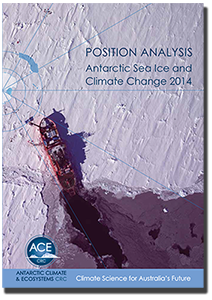MEDIA RELEASE
Low winter sea ice coverage around Antarctica

There has been a noticeable reduction in winter sea-ice coverage around Antarctica in recent weeks, with sea ice extent starting its annual retreat early and setting new daily record lows for much of the past week.
The result comes two years after winter sea ice extent around Antarctica reached a new record high in September 2014, when it exceeded 20 million square kilometres for the first time since satellite measurements began in 1979.
This year, Antarctic sea ice began its annual spring retreat roughly four weeks earlier than average, after peaking at 18.5 million square kilometres on 28 August 2016, which was close to the lowest winter maximum on record.
Dr Jan Lieser from the Antarctic Climate and Ecosystems Cooperative Research Centre and the Australian Research Council-funded Antarctic Gateway Partnership said it was a surprising finding, given the trend in recent years.

Figure 1: Dark blue line represents 2016 sea ice extent. Light blue area represents maximum/minimum recorded extent between 1979-2015. Black line represents average extent between 1979-2015.
“This is a reversal of the recent trend towards record high winter sea-ice extent over the past few years,” said Dr Lieser.
“Within the space of just two years, we have gone from a record high winter sea-ice extent to record daily lows for this point in the season.”
“This is a fascinating change, and a great reminder that we are dealing with an extremely variable component of the climate system.”
“It’s also a reminder of why it can be unwise to leap to conclusions about the link between Antarctic sea ice and climate change on the basis of one or two years of data.”
“It is the long-term trends that are most important, as well as the regional variability, which is high around Antarctica.”
Sea-ice has an important effect on the global climate system and ecosystems, by covering and affecting up to 40% of the Southern Ocean surface area during winter.
Its annual cycle of advance and retreat represents one of the greatest seasonal changes to the Earth’s surface, and has far-reaching impacts on atmosphere-ocean interactions and the Earth’s climate.
Dr Lieser said he and his colleagues were working to understand the drivers of change and variability in sea ice coverage.
“It’s likely that last year’s powerful El Nino event is playing a role in this year’s sea-ice distribution, but there is also a likely contribution by weather events at the local scale.”
“Sea ice cover in the Arctic has been reducing steadily over the past several decades, and climate models also predict that over time sea ice will also reduce around Antarctica.”
“It will be very interesting to see how the Antarctic sea ice extent varies over the coming years.”























